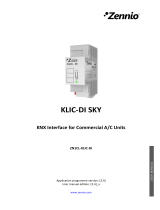Page is loading ...

KNX USB SC
http://www.zennio.com Technical Support: http://support.zennio.com
2
CONTENTS
Contents ........................................................................................................................................ 2
1 Introduction .......................................................................................................................... 3
1.1 KNX USB SC .................................................................................................................... 3
1.2 Installation ..................................................................................................................... 4
2 Configuration......................................................................................................................... 6
3 ETS Parameterisation ............................................................................................................ 7

KNX USB SC
http://www.zennio.com Technical Support: http://support.zennio.com
3
1 INTRODUCTION
1.1 KNX USB SC
KNX USB SC is the solution from Zennio for the interconnection between a PC and the
KNX bus via USB with no need of external power.
This interface permits interacting with the various devices connected to the bus, and
performing tasks such as:
Address, parameter and application program downloads to KNX devices.
Bus diagnostics.
Connection and data transfer monitoring.
Among the features of the device, the most outstanding are:
Low consumption.
Easy installation and use.
USB 2.0 compatibility.
Status LEDs.
Support for long messages (up to 220 bytes).
Electrically isolated bus connection.
Compatibility with applications & platforms unsupported by the KNX
FALCON driver (e.g.: Linux).

KNX USB SC
http://www.zennio.com Technical Support: http://support.zennio.com
4
1.2 INSTALLATION
Figure 1 shows a scheme with all the LES indicators and required connections. This
device does not require an external power supply, it is powered through KNX bus and
USB connector.
Figure 1 Element Scheme
Zennio KNX USB Interface features two external connectors, one for connecting the
KNX bus (5) and another one for connecting to the PC (3). The latter requires a
standard USB cable with one B type end.
A short description of the main elements is provided next:
USB connection indicator LED (1): this orange LED will turn on once the
connection has been established between the USB interface and the PC.
This connection is required before performing any actions with the
programmer.
Note: being this LED on does not necessarily guarantee a correct
communication between the interface and the PC. To ensure a proper
communication, performing a connection test in ETS is advised.
KNX connection indicator LED (2): this orange LED will turn on once the
connection has been established between the interface and a properly
powered KNX bus.
1. USB connection indicator LED
2. KNX connection indicator LED
3. USB connector
4. DIN rail anchorage
5. KNX connector
36
70
89
2
5
4
1
3

KNX USB SC
http://www.zennio.com Technical Support: http://support.zennio.com
5
Note: in case the interface is not properly connected to a PC through the
USB port, this LED will remain off even if the bus connection has been
established.
Data transfers will make the LEDs blink. Therefore, for example, the USB LED will
blink during the assignment of an individual address to Zennio KNX USB Interface,
while it will be both LEDs that blink during an ETS download to another device
connected to the bus.
For detailed information about the technical features of the device, as well as on
security and installation procedures, please refer to the device Datasheet, included
within the device packaging and also available at www.zennio.com.

KNX USB SC
http://www.zennio.com Technical Support: http://support.zennio.com
6
2 CONFIGURATION
On the first connection of the device to the USB port of the PC, it will be necessary to
install the corresponding device driver to the operating system, in order to make ETS
detect it (although it will probably be installed automatically when connecting the USB
to the PC). Two alternate procedures are possible:
Running the standalone driver installer file, or
Importing the device database to ETS, as the driver is provided embedded
into the database, therefore making the installation transparent to the user.
Both can be downloaded from the Zennio website: www.zennio.com, section Products
> System > KNX USB SC.
Once the driver is installed, it will be possible to use and configure the device in ETS or
any other KNX diagnose tool.

KNX USB SC
http://www.zennio.com Technical Support: http://support.zennio.com
7
3 ETS PARAMETERISATION
This device does not require the download of an application program to start working.
Nevertheless, in order to make it possible to include the device within an ETS project,
the corresponding database (KNX USB SC) is provided, however, it does not contain
parameters, application programs or communication objects.
In addition, ETS may be used to set a basic configuration. The configuration options
can be found by accessing Extras > Options (ETS3) or Communication from ETS >
Setting (ETS4) or Options from ETS > Bus > Connections (ETS5).
The most significant options available under this tab are:
Device individual address: by default, it will be 0.2.255.
Selection and test of the desired interface, useful in case of having several
USB interfaces connected to the same PC.
For detailed information about the USB interface configuration process from ETS,
please refer to the ETS user manual and to the Help menu on the program itself.
/










